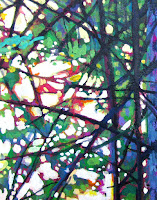Greetings Fellow Creatives!
As you can see, I went to THE Museum of Fine Arts on Sunday to view the Dutch Masters. While I was strolling through the galleries, I observed a visual thread that seemed to originate in the paintings of Vermeer and de Hooch and was later reinvented in the works of Piet Mondrian.
This way of abstracting structure is very much operating in my own work. If you look at the painting to the left, "The Astronomer" by Johannes Vermeer, the composition shows large almost geometric shapes made by the chair, the back wall, back cabinet and the rectangular painting which visually hems our astronomer into place. He has a gridded window onto the world and by touching a globe, through the arrangement of diminishing puzzle pieces we can visually feel the acceleration of his mind imaging enormous spaces. beyond his cramped interior.


In this painting, "Two Women Beside a Linen Chest with a Child" by Pieter de Hooch, the interior is neatly organized into sensible grids that relate in layers as you move through the space towards the back room. Notice the small patch of blue sky in the middle of the painting. I am reminded of virtual landscapes of the online games which seem to employ similar compositions.
Compare the two styles below, de Hooch on the left and Mondrian on the right. All of these paintings organized the space by the mapping and the measurement of portions in relation to the whole. The architectural designs of Theo Van Doesburg, founder of the De Stijil movement demonstrates how this way of abstractly composing can create Modern Architecture. The fitting together of bits like the pixels in a digital photograph started with this idea of components. Now we find it difficult to see in any other way and I think it started in the small quiet interior paintings from a nation that once ruled the oceans from their tiny little row houses.






So the nature of how you divide up the whole becomes an understanding of inherent structures. These constructs exist at many layers with the human mind jumbling the pieces and reassembling them over and over in new ways.
Each time the tangram is put together, new relationships are seen. We find pleasure in making new files in our imaginations to view the whole in a different light. As fresh images inspire new harmonies, there is a never ending supply of wonder to fuel the artistic heart.
At every scale no piece is expendable and all parts are inseparable from one another and the Whole. For me observing the infinite flux of these patterns is a doorway to the presence of the Ineffable and a modern take on what we can't know but it has never stopped us from trying.








 In this painting, "Two Women Beside a Linen Chest with a Child" by Pieter de Hooch, the interior is neatly organized into sensible grids that relate in layers as you move through the space towards the back room. Notice the small patch of blue sky in the middle of the painting. I am reminded of virtual landscapes of the online games which seem to employ similar compositions.
In this painting, "Two Women Beside a Linen Chest with a Child" by Pieter de Hooch, the interior is neatly organized into sensible grids that relate in layers as you move through the space towards the back room. Notice the small patch of blue sky in the middle of the painting. I am reminded of virtual landscapes of the online games which seem to employ similar compositions.







 So the nature of how you divide up the whole becomes an understanding of inherent structures. These constructs exist at many layers with the human mind jumbling the pieces and reassembling them over and over in new ways.
So the nature of how you divide up the whole becomes an understanding of inherent structures. These constructs exist at many layers with the human mind jumbling the pieces and reassembling them over and over in new ways.